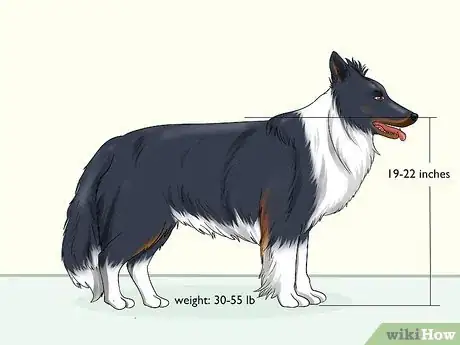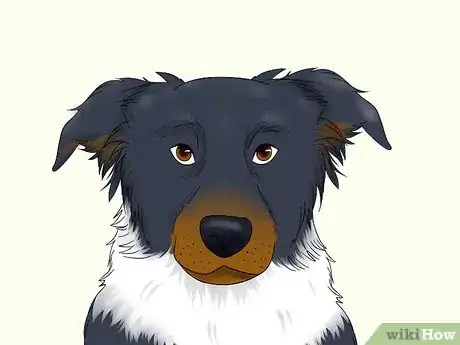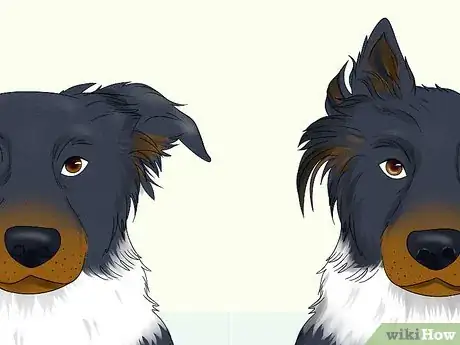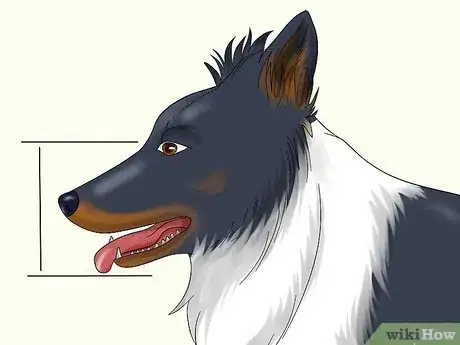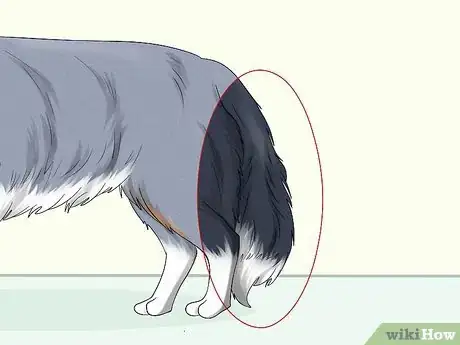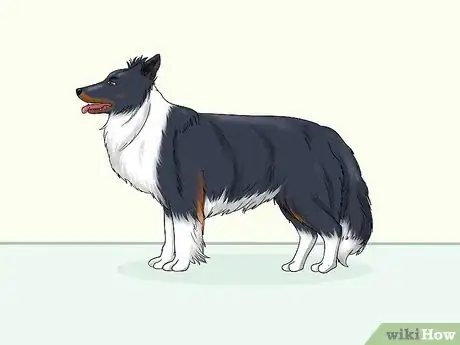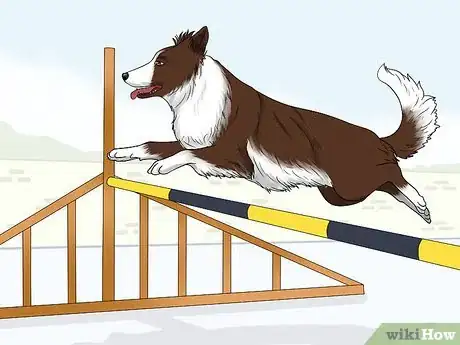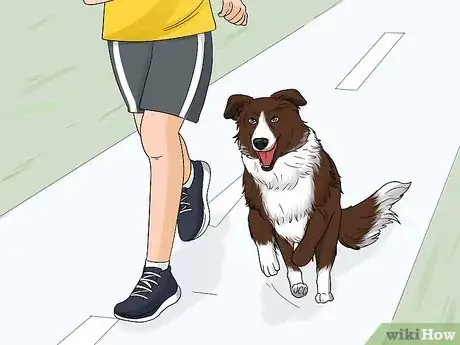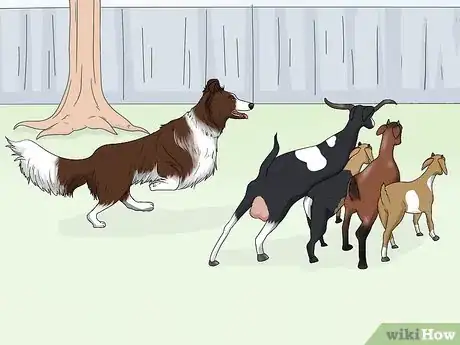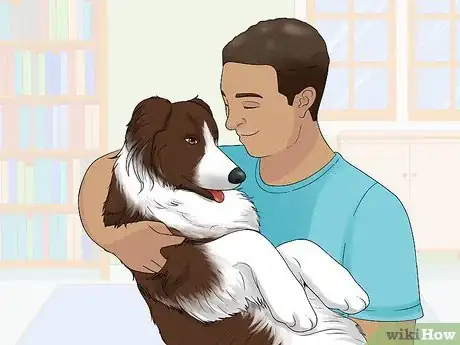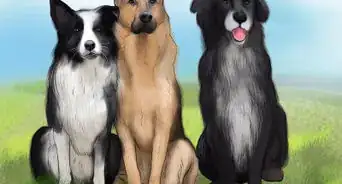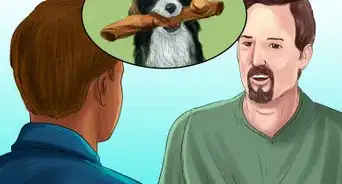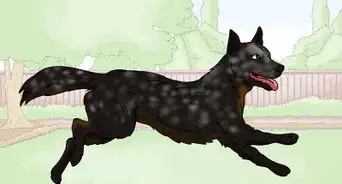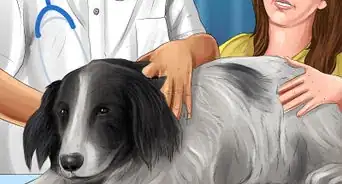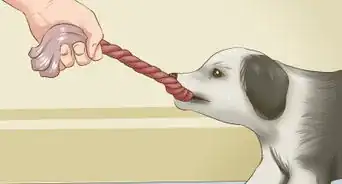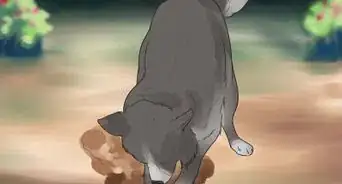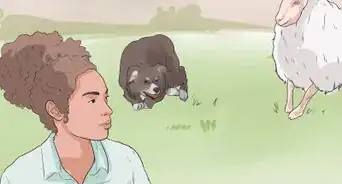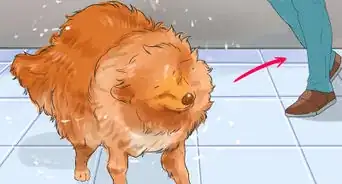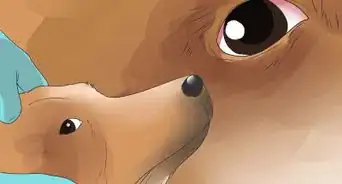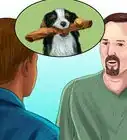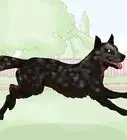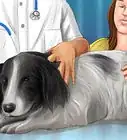This article was co-authored by Toni Woods. Toni Woods is a Professional Dog Trainer in Washington DC. With over 15 years of experience, Toni specializes in improving the relationship between dogs and their families and easing the suffering of dogs experiencing separation anxiety. Toni holds a BS in Biology from Wittenberg University and taught biology for nine years. She now dedicates her life to helping dogs with separation anxiety.
This article has been viewed 33,880 times.
Border Collies are medium-sized dogs and a popular member of the herding group.[1] Also called Borders, they are often considered one of the most intelligent and trainable dog breeds.[2] Border Collies share some traits with other breeds, but by recognizing their key traits, Borders can be more easily identified. This wikiHow will help you know whether a dog is a Border Collie.
Steps
Inspecting the Body Structure
-
1Notice the dog's size. Border Collies are medium in size. They weigh from 30 to 55 pounds (14 to 25 kg), males standing at 19–22 inches (48–56 cm) tall and females being 18–21 inches (46–53 cm) in height.[3]
-
2Look at the eyes. The eyes of a Border Collie are set well apart. They are of moderate size, oval in shape, and may be any color, though blue eyes in dogs other than merle are not preferred.[4]Advertisement
-
3Check the ears. Borders have either erect or semi-erect ears, the latter having tips that fall forward or outward, or may have one of each. The ears are medium in size and are set well apart.[5]
-
4View the muzzle. A Border's muzzle is strong and tapers slightly to the nose, with the sides of the head tapering smoothly into the muzzle. The nose is fully pigmented, and Borders have a scissors bite.[6]
-
5Inspect the tail. Border Collies have moderately long tails that are set on low. The tail is carried low and may have a slight upward swirl at the end when the dog is concentrating and may be raised when the dog is excited.[7]
-
6Examine the dog's overall structure. The build of a Border is well-balanced and athletic, being medium in size. The body is hard and muscular, with a level back and parallel legs.[8] They convey the impression of endless endurance and effortless movement, and they have a balanced, graceful, agile gait.[9]
Identifying the Coat
-
1Differentiate between coat types. Border Collies have dense, weather-resistant double coats, including an either straight or slightly wavy coarse outer coat and a soft, dense undercoat.[10] A Border Collie may have one of two coat types: rough or smooth.
- Rough coats may vary in length but are made up of feathered forelegs, haunches, chest, and underside, while the face, ears, feet, and fronts of the legs are short and smooth.[11]
- Smooth coats are short on the entirety of the body, though they may have slight feathering on the forelegs, haunches, chest, and ruff, and are usually coarser than the rough variety.[12]
-
2Understand that a Border Collie can be any color. A Border Collie may be seen sporting a coat of any color or pattern. No color or pattern is more acceptable than others as all are seen.[13]
-
3
Noticing Temperament
-
1Recognize intelligence. Border Collies are thought of by some to be the smartest dog breed. They need ongoing mental stimulation to stay occupied due to their high intelligence, such as canine sports.[16]
-
2See if the dog is athletic. Borders are very active and athletic dogs. They need at least an hour of exercise daily to meet their high-energy needs.[17]
-
3Take note of alertness. Known to be very vigilant and alert, Border Collies always keep an eye on their families. They will also bark to alert their owners of any potential threats.[18]
-
4Expect a herding instinct. Borders were bred to be herding dogs, so it's only natural to expect a strong herding instinct from one. They may try to herd children, cats, or other animals.[19]
Did you know? Border Collies are known for a herding technique called "the eye" where they stare intensely at a flock to intimidate them.[20]
-
5Watch for loyalty. Developing deep bonds with their owners, Border Collies are very loyal dogs. This can make them good family dogs, though they may form an especially close bond with one family member.[21]
Community Q&A
-
QuestionWill a Border Collie herd cattle?
 LinnieTop AnswererYes. Border Collies are known for being excellent herders and enjoy working, and though they were traditionally used to herd sheep, they are regularly used to herd cattle today.
LinnieTop AnswererYes. Border Collies are known for being excellent herders and enjoy working, and though they were traditionally used to herd sheep, they are regularly used to herd cattle today. -
QuestionDoes a border collie have a low-hanging rib cage?
 LinnieTop AnswererBorder collies have well-sprung ribs that are moderate to long in length. With a slight tuckup, the chest and ribs usually hang near the dog's elbows.
LinnieTop AnswererBorder collies have well-sprung ribs that are moderate to long in length. With a slight tuckup, the chest and ribs usually hang near the dog's elbows.
References
- ↑ https://www.akc.org/dog-breeds/border-collie/
- ↑ https://www.akc.org/expert-advice/lifestyle/13-of-the-most-trainable-breeds/
- ↑ https://www.akc.org/dog-breeds/border-collie/
- ↑ http://images.akc.org/pdf/breeds/standards/Border_Collie.pdf
- ↑ http://images.akc.org/pdf/breeds/standards/Border_Collie.pdf
- ↑ http://images.akc.org/pdf/breeds/standards/Border_Collie.pdf
- ↑ http://images.akc.org/pdf/breeds/standards/Border_Collie.pdf
- ↑ http://images.akc.org/pdf/breeds/standards/Border_Collie.pdf
- ↑ http://images.akc.org/pdf/breeds/standards/Border_Collie.pdf
- ↑ http://images.akc.org/pdf/breeds/standards/Border_Collie.pdf
- ↑ http://images.akc.org/pdf/breeds/standards/Border_Collie.pdf
- ↑ http://images.akc.org/pdf/breeds/standards/Border_Collie.pdf
- ↑ http://images.akc.org/pdf/breeds/standards/Border_Collie.pdf
- ↑ https://www.akc.org/about/glossary/
- ↑ http://images.akc.org/pdf/breeds/standards/Border_Collie.pdf
- ↑ https://www.dogtemperament.com/border-collie-temperament/
- ↑ https://www.dogtemperament.com/border-collie-temperament/
- ↑ https://www.dogtemperament.com/border-collie-temperament/
- ↑ https://www.dogtemperament.com/border-collie-temperament/
- ↑ https://www.akc.org/expert-advice/lifestyle/10-border-collie-facts/
- ↑ https://www.dogtemperament.com/border-collie-temperament/
